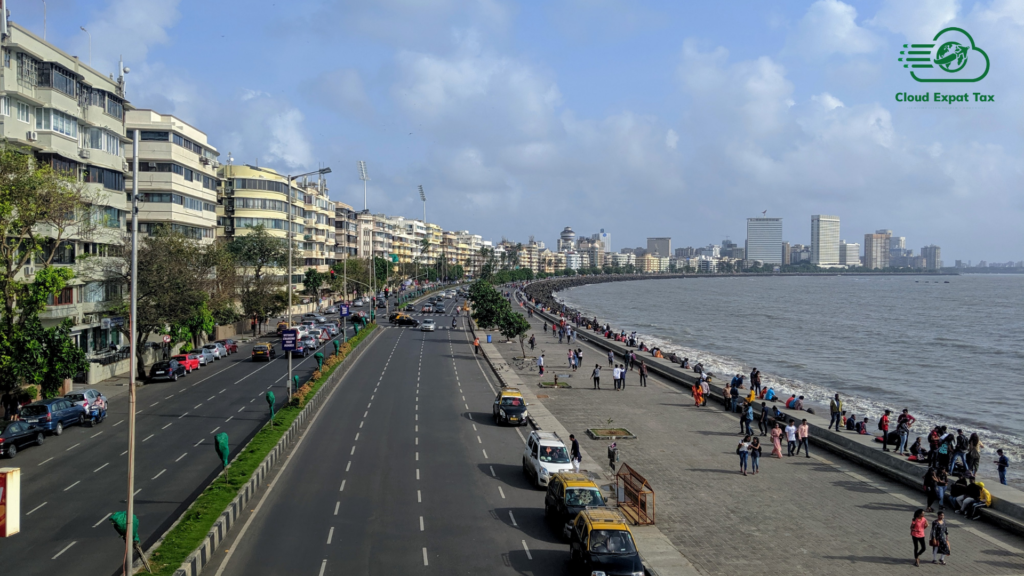TAXES FOR
US EXPATS IN INDIA
TABLE OF CONTENTS:
- Introduction
- Do US Expats in India have to file their tax returns?
- How is Indian income taxed on the US tax return?
- Can US expats and Green card holders in India get relief from double taxation?
- What about reporting of Foreign bank accounts and other Foreign financial interests in India?
Introduction
US Expats in India make up a minuscule number compared to the 1.4 billion people, who call India their home. The booming economy has led to a large number of expatriates in the country. At the same time, India is also one of the biggest beneficiaries of the H1 Visa program. A good number of US expats in India come from this population as well.
In this blog, we will discuss in detail the filing obligations of US expats living and working in India.
Updated as of 11/14/2023.
Do US Expats in India have to file their US Tax Return?
Yes, a US Citizen, Green Card Holder must file taxes for the current tax year to report all wages, interests, dividends, self-employment, rental income Etc..on their U.S. Tax Return.
US Citizens and Green Card Holders are subject to taxes on their worldwide income, irrespective of their residency. If you are an Indian Green Card holder you should be filing taxes each year to be in the good books of USCIS. If your total US taxable income is above a certain threshold, depending on your filing status, or self-employed with income over $400, you must file your tax return. If you would like to claim a refund on the withholding, because your income was less for the year or to claim a tax credit, you must file a tax return.
(The Table below can be used as an Expat Tax Calculator for the Tax Year 2023)
| Filing Status | Age | Minimum Income requirement |
| Single | Under 65/65 and older | $13,850 and $15,700 |
| Married filing Joint | Under 65/65 and older | $27,700 and $29,550( both over 65) |
| Married filing separately | Any age | $5 |
| Head of Household | Under 65/65 and older | $20,800 and $22,650 |
| Qualifying widow with dependent child | Under 65/65 and older | $27,700 and $29,550( both over 65) |
| Self-employed | Any age | $400 |
If your Gross Income for the year is above the threshold mentioned in the table, you must file your US Tax Return.

How is Indian income taxed on the US tax return?
The tax rates in India are very steep, however, they are simply not high enough.US Expats/Green Card Holders have to report worldwide income from all sources. For employment income in India, Form 16 is issued by the Indian employer, which is similar to Form W2 in the US. Interest income is taxable in India. Previously, dividends were only taxed to the companies, now the finance Act 2020 has shifted back to the classical system of taxing dividends in the hands of shareholders/unitholders from 01 April 2020. Capital Gains in India are taxed at different rates based on the holding period. It could be anywhere between 10% to 20%.
Like the US, India Taxes its Residents on World-Wide Income. Non-Residents are only taxed on India source income. If your income in India is more than Rs 500,000 ($600,000) for the AY 2023-24, you must file your tax return in India.
For employment income, India has 2 slightly different tax regimes. The old regime had deductions for housing, standard deductions, health premium deductions, contribution to the government pension plan (Public Provident Fund), deduction on Interest of Home loans, and many more.
These deductions are completely done away with in the new tax regime, which has made reporting a lot easier. However, it is less tax-favorable.
From AY 2024-25, the new tax regime is available for individuals with lower tax rates and zero deductions/exemptions. The US expat can choose which regime they want to be a part of for taxation for the AY 2024-25 Tax Year.
New regime slab rates | Existing regime slab rates | ||
|
| Income from Rs 2.5 lakh to Rs 5 lakh | 5% |
Income from Rs 5 lakh to Rs 7.5 lakh | 10% | Income from Rs 5 lakh to Rs 10 lakh | 20% |
Income from Rs 7.5 lakh to Rs 10 lakh | 15% | Income above Rs 10 lakh | 30% |
Income from Rs 10 lakh to Rs 12.5 lakh | 20% |
|
|
Income from Rs 12.5 lakh to Rs 15 lakh | 25% |
|
|
Income above Rs 15 lakh | 30%
|
|
|
* Lakh = One Hundred Thousand or 100k and 1 Crore = 10 Million.
Can US EXPATS AND GREEN CARD Holders in INDIA GET RELIEF FROM DOUBLE TAXATION?
For US Expats in India, you might be eligible for the Foreign earned Income exclusion (FEIE), Foreign Housing Exclusion, or a Foreign Tax Credit (assuming taxes were paid/withheld abroad in India). India shares a Double Taxation Agreement Treaty with the United States. For Salaried employees in India, taxes are usually withheld on their monthly payslip, known as TDS (Tax Deducted at Source). For the 2023 Tax year, the Foreign earned income for exclusion is $120,000. In addition to this, you can claim Foreign housing exclusion/deduction as well, which is subject to some threshold limit.
Form 2555 needs to be completed under the Bonafide Residence Test (BFR) or Physical Presence Test (PPT). This form is an election in itself, hence some tax planning is needed in advance to make the best use of it.
An optimization calculation is needed in the year of departure on whether to claim FTC or FEIE. Unlike the US, India follows a fiscal year for taxes. The filing deadline is July 31st of the following year after the close of the tax year which starts from April 1st and ends on March 31st. The 2023-24 taxes are due by July 31st, 2024. The assessment year of the taxes paid in 2023-24 will be 2024-25.
Another point to remember is to have a valid PAN card. The PAN card is needed to file the Income Tax Return in India. All financial transactions in India will need a PAN card.
WHAT ABOUT REPORTING OF FOREIGN BANK ACCOUNTS AND OTHER FOREIGN FINANCIAL INTERESTS FOR US EXPATS IN INDIA?
Both India and the United States have signed the FATCA Agreement in addition to the double tax treaty. For a US expat in India, American Green Card Holder, or for that matter an L1/H1 Visa Indian national working in the US, has to be FATCA Complaint, if the Indian assets are above a certain threshold.
Let us start with the Indian bank accounts held by US Expats or Green Card Holders. If they cross a certain threshold (more than $10k), FBAR or FinCen114 needs to be filed with the Department of Treasury. Similarly, if you have assets or Financial interests over the threshold limit, Form 8938 needs to be filed.
US citizens of Indian origin usually open the NRE (Non-resident External) and (Non-Resident Ordinary) in India. Both accounts have different purposes and need to be reported for FBAR & FATCA Form 8938 requirements. Interest from an NRE account is exempt in India, however, being exempt in India does not automatically exempt it on the US tax return.
Shares of Private limited companies are owned through a Demat Account (Stock Account in digital format) in India through a private broker. These shares are required to be reported for FBAR & FATCA.
Foreign Mutual Funds need reporting on Form 8621 if they meet the threshold requirement along with the Asset and Income Test (PFIC or Passive Foreign Investment Company). Mutual funds in India will also be reported through the Demat Account.
Do you own and run an Indian Private Limited Company?
If yes, you may have a Form 5471: Information Return of U.S. Persons With Respect To Certain Foreign Corporations. If you own Indian Partnerships, you would have to file Form 8865: Return of U.S. Persons With Respect to Certain Foreign Partnerships.
Life insurance Policy through an Indian Insurer like LIC (Life Insurance Corporation of India), if it has a surrender value, needs to be reported for FBAR & FATCA Form 8938. If you are paying premiums to LIC or another foreign life insurer broker, Form 720 – Quarterly Excise Tax Return is needed for each quarter you paid premiums. The madness doesn’t stop here. The IRS expects you to have an EIN to file this Form 720. Crazy!
Coming to pension plans, India has PPF (Public Provident Fund) a tax-deferred retirement plan similar to the IRA in the US. This needs to be reported on your FBAR & Form 8938.
Similarly, the employer-sponsored (partially) EPF (Employee provident fund) also needs to be reported on the FBAR & FATCA Form 8938.
Finally, do you own a rental property in any of the major cities or towns in India? Foreign rental property as a business needs to be reported on Form 8858. These are a few reporting requirements of an US expat in India. The IRS is very strict when it comes to compliance of Foreign financial interest reporting on the US tax return. Penalties for missing the above-mentioned forms start at $10,000 for each failure to report these accounts. Miss a few forms here and there, you are looking at a pile of massive penalties.
If you have any questions, give us a call or drop us an email at SuperExpat@cloudexpattax.com
DISCLAIMER: The above info should only be considered for the knowledge of US Tax. Every Taxpayer’s situation is unique, strongly advise you to consult a tax professional.

